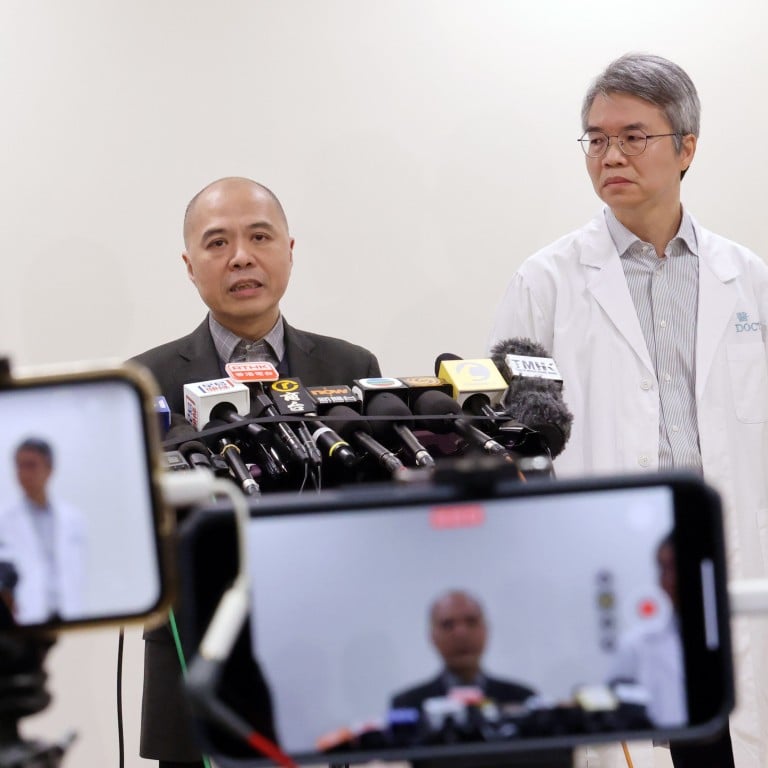
Hong Kong patient in a critical condition after tube detaches from ventilator machine in isolation ward
- Kwong Wah Hospital revealed patient, 51, had been alone in an isolation ward at time of incident and staff did not hear safety alarm
- Patient’s body movements may have caused tube to become disconnected even though he was restrained with a strap, hospital chief says
A middle-aged Hong Kong tuberculosis patient has been left in a critical condition after his heart stopped when a tube detached from his ventilator machine in a suspected medical blunder.
Kwong Wah Hospital in Yau Ma Tei revealed on Thursday that the patient, 51, who had been diagnosed with pulmonary tuberculosis and was alone in an isolation ward, fell unconscious on February 5 and his heart stopped when the ventilator tube detached.
The man was resuscitated, regained a pulse and was sent to an intensive care unit for treatment, according to hospital chief executive Dr Tang Kam-shing.
Tang said the ventilator had been functioning when the tube disconnected.
Because of the isolation ward’s double doors, hospital staff did not hear the safety alarm when the tube became detached and the nurses’ station did not receive a warning from a remote-monitoring system that was connected to the patient’s vital signs machine.

It remained unclear how long the patient’s heart stopped.
Tang said preliminary findings showed the patient’s body movements might have caused the tube to become disconnected even though he was restrained with a strap.
“We are sad about the incident, explained to the patient’s family the situation and will provide support to the family,” Tang said.
He stopped short of apologising to the family. A source said the patient remained unconscious.
Tang said the hospital had set up a committee to investigate the incident.
According to the hospital, the patient was first admitted in December with symptoms of sepsis, shock and respiratory failure and was in a critical condition. About a month into treatment, his condition became stable and he was moved from intensive care to a one-patient isolation ward on February 5.
Unclear Hong Kong medical staff roles partly to blame for death of patient: report
The patient then had his hands secured with a strap to minimise his movements so the ventilator’s operation would not be disrupted.
“We cannot secure the patient too tightly, or hurt his hands and joints,” Tang said.
A nurse carrying out a check at 4.40pm on February 5, less than an hour after the previous one, found that a ventilation tube had disconnected from the machine and that the patient had lost consciousness and had no heart beat. The machine was still operating.
Tang said the disconnection triggered an alarm, but the double-door design of the isolation ward meant nurses were not aware of it. Nurses did not receive a notification over the remote-monitoring system connected to the vital signs machine in the ward.
The nurses’ station also had connections with 14 vital signs machines in other wards, and the remote-monitoring system functioned properly, Tang said.
“Why the remote-monitoring system of the isolation ward did not show any alert is a subject of our investigation,” he said. “We have downloaded all the data and sent it to the supplier of the machine for analysis.”
Probe launched into Hong Kong patient’s death after staff find closed oxygen valve
Tang said a check of closed-circuit television footage, interviews with nurses, and the nature of the isolation ward – where only staff entered – led to the belief that the disconnection was likely to have been caused by the patient’s movements.
He added that there were no manpower issues at the time as seven nurses and two medical assistants were looking after about 40 patients, or 80 per cent of the ward’s capacity.
Tang did not comment on whether human error was involved in the incident.
Patients’ rights advocate Tim Pang Hung-cheong of the Society for Community Organisation said it was difficult to determine at this stage whether the suspected blunder involved human error.
Hong Kong patient death sparks calls for experienced staff to handle transfers
“At the moment, it seems this incident is unlike other medical blunders which involved clinical treatments or care procedures,” Pang said. “It seems to be more related to the problems of systems or facilities.”
He said apart from reviewing why signals of the vital signs machine were not sent to the nurses’ station, the Hospital Authority should also consider adding visual warnings, such as flashing lights, outside isolation wards.
He urged the authority to also conduct immediate checks on all its isolation wards to see whether there were any transmission problems to nurses’ stations.
Last year, a newborn twin died in a medical blunder at Prince of Wales Hospital in Sha Tin. A nurse with more than 20 years’ experience failed to turn on the valve of an infusion line, resulting in medicine not reaching the premature baby girl, who had been diagnosed with congenital heart problems. She died the day after her birth.


